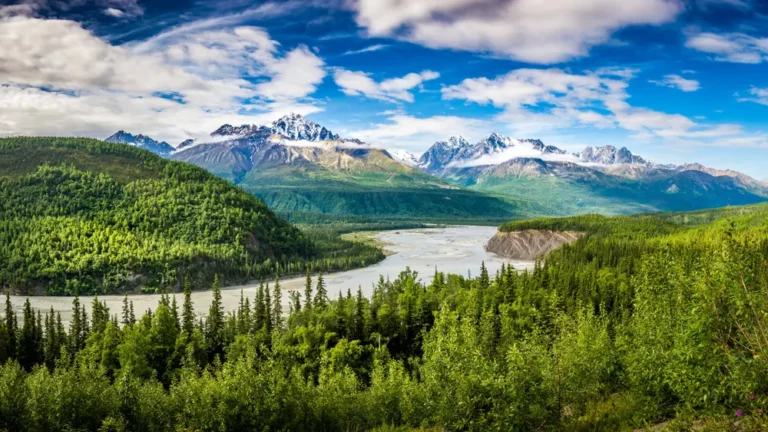Alaska, the Last Frontier, is a stunning destination that captivates all who venture there. However, it’s important to carefully plan your visit as there are certain times that might dampen your experience. From bone-chilling temperatures to limited accessibility, this article will explore the worst time to visit Alaska and offer helpful insights to ensure your trip is a memorable one.
Winter (December to February)
Winter in Alaska can be harsh with subzero temperatures and very limited daylight, making outdoor activities difficult and some attractions inaccessible. The cold weather can often drop to -20°F (-29°C) or even lower, and the limited daylight with just a few hours of sunlight per day can affect your plans. Many outdoor activities such as hiking, camping, and wildlife viewing might not be feasible during this time due to safety concerns and unfavorable conditions. Additionally, some attractions like national parks or seasonal tourist spots may be closed or have limited services. It’s important to be well-prepared with proper winter clothing and equipment if you choose to visit Alaska during this time, but keep in mind the challenges you may encounter.
The Wettest Season (April to September)
Spring and summer in Alaska bring heavy rainfall and increased mosquito activity, which can hinder outdoor explorations and make hiking and camping less enjoyable. During this time, it is important to be prepared for wet weather conditions and to pack appropriate rain gear. Despite the rain, the wet season also offers opportunities to witness the beauty of Alaska’s lush, green landscapes and stunning waterfalls.
The Rainy Month of August
August is known as the wettest month in Alaska, with heavy rainfall that can limit outdoor activities and obscure scenic views. Backpacking and camping may become challenging due to muddy trails and wet conditions. However, this doesn’t mean you can’t enjoy your trip to Alaska during this month. Pack waterproof clothing and plan activities such as visiting indoor museums, art galleries, or taking scenic drives to make the most of your trip even when the rain comes pouring down.
The Peak Mosquito Season (June to July)
During June and July, mosquito populations in Alaska are at their highest. This can make outdoor activities uncomfortable and even unbearable for visitors. The relentless buzzing and biting of mosquitoes can greatly affect the overall experience of exploring Alaska’s beautiful landscapes. To make the most of your trip during this time, it is essential to take extra precautions such as using insect repellent, wearing long sleeves and pants, and avoiding peak mosquito activity times like dawn and dusk. Additionally, consider staying in accommodations with screens or mosquito nets to create a more enjoyable environment.
Southeast Alaska in August
August is another time to take caution when visiting Southeast Alaska, especially in areas like the Tongass National Forest. The region experiences a peak in mosquito activity during this month, which can deter outdoor adventurers from fully embracing their surroundings. Hiking, camping, and even simply enjoying a picnic can be less ideal due to increased mosquito annoyance. If you plan to visit Southeast Alaska in August, remember to pack mosquito repellent, wear protective clothing, and be prepared for encounters with these pesky insects. Despite the mosquitoes, the stunning beauty of the region still awaits, so don’t let them discourage you from exploring!
The Short Summer Season (May to August)
Alaska’s summer season is relatively brief, spanning from May to August. During this time, visitors have only a limited window of opportunity to enjoy the warm weather and witness the abundance of wildlife that Alaska has to offer. The short duration of the summer season means that travelers must plan their trips strategically to make the most of their time in the state.
The Crowded Months of June and July
June and July are the peak months for tourism in Alaska, attracting a large number of visitors from around the world. As a result, these months tend to be the busiest, with greater crowds and higher prices. While the influx of tourists brings energy and excitement to the state, it can also detract from the tranquility and pristine nature that many seek when visiting Alaska. Travelers who prefer a more peaceful experience may want to consider visiting during the shoulder seasons of May or August, when the crowds are thinner and prices may be lower.
The Dark Winter Months (November to February)
The winter months in Alaska, from November to February, are characterized by limited daylight, which can pose challenges for visitors seeking to fully experience the beauty of the landscapes and engage in outdoor activities. With shorter days and longer nights, it can be difficult to make the most of your time in Alaska during this period.
The Challenging Month of January
January is renowned as one of the darkest months in Alaska, with only a few precious hours of daylight. This can present a significant hurdle for visitors looking to embark on outdoor adventures. The limited daylight hours not only limit the time available for activities, but they also affect visibility, making it harder to fully appreciate the majestic wilderness that Alaska has to offer.
In conclusion, while Alaska offers breathtaking landscapes and unique wildlife that can enchant any adventurer, there are certain times of the year that are best to avoid visiting. This article has shed light on the worst times for an Alaskan adventure, when extreme weather conditions, fewer outdoor activities, and limited accessibility can hinder your experience. By planning your trip wisely and considering factors such as weather patterns and tourist season, you can ensure a more enjoyable and fulfilling adventure in the Last Frontier. So, next time you plan your Alaskan getaway, be sure to consult this guide and make the most of your time in this captivating region.
